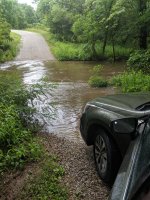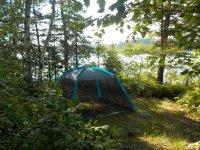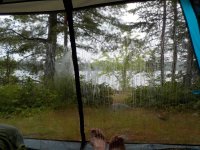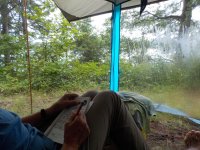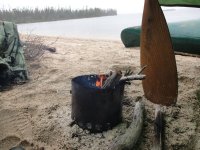Moving camp and travelling there is only so much you can do while paddling the canoe. As before, spray covers help, good raingear helps even more. A good rain hat, one that doesn’t pour water down the back of your neck, is a huge dry-head help. And a dry head, like a warm head, is incredibly important.
I do not like wearing a rain jacket hood. The brim rarely provides enough brimmed face protection when paddling into wind and rain, it rustles around my ears disturbing my auditory sense and, unless snugged down mummy-bag hood cinched style, with face in a drawstring puckered cowling, when I turn my head to look sideways I’m often staring at the inside of the hood. I did not come this far to inspect the lining of my hood
Hood-hater rant over. A wide brimmed waterproof hat, pick ‘em as suits your head shape and style.
In camp I think a lot of staying dry is simply experience, as often involving bad experience and developing better judgment. Not just avoiding setting the tent up in a rainy hog wallow depression just ‘cause it seems the flattest place available, but pausing to select the best location and orientation for the tent and tarp for the anticipated weather.
Even that, knowing from experience how to read local weather patterns and clouds; did not come quick for me, less so in distant infrequent paddling locations.
I am not the fastest observational tack in the box. Once I finish carrying gear to camp, (sometimes
I need-a-break before I’m finished), I’ll have a sit in my camp chair and more carefully unhurried observe the site, with an eye on tent and tarp location for wind and weather exposure.
Part of keeping dry and staying dry while in camp is simply not rushing those couple critical shelter locations, and after that observing a few best in-camp practices.
Wet shoes and dry shoes and never the twain shall meet. I am the Imelda Marcos of tripping shoes; I want water shoes or Mukluks while paddling, wading or wet foooting. I want dry camp shoes; my favorite are Gore-Tex lined trail runners, so the water dripping down my rain pants doesn’t soak my shoes. And I want some
let my tootsies dry out in-between-the switch footwear, Crocs or flip flops or moccasins depending on the venue and season. None of those weight much, and mocs don’t take up much packing space.
Mostly those best practices come down to keeping the wet stuff away from the dry stuff. Not rain jacket dripping all over my once dry camp chair and journal is a good start, but also obvious things like:
Keeping dry stuff dry, not incautiously dropping things unprotected at the rain spattered edge of the tarp, to eventually get windblown damp. If I don’t need it now, or soon, it can stay in a dry bag, in the vestibule or, if bedding, sit protected but prepped for sleepytime in the tent. In other words, don’t be sloppy. Anyone who has tripped with unawares or unobservant companions has probably seen sloppy, and the aftermath.
Oh the tales of unawares or incautious. Friend Topher, sleeping under a tarp, awoke one morning to discover than an Assateague pony had wandered in and was straddling his sleeping bag, licking spills off the camp table. The well-hung stallion, in Topher’s retelling, was aroused by the spills, and was dangling a large pony protrusion inches from Topher’s nose. Gawd I only wish there was a photograph.
Pony play aside, I have only been personably pleased by rainsloppy results once. Some guy brought an MP3 player and small speakers on a group trip, and “entertained” us with his playlist. I spent a lot of time wandering afar from camp that evening. He left his electronica out in the overnight rain, orr maybe someone who need a wee hours piss submerged it in a bucket of water, I dunno. I was so sad for him the next morning.
Back on topic. Add not climbing into the tent sopping wet. I take my raingear and any wet/damp stuff off under the tarp before climbing inside the tent; again, gawd bless the paddler’s parasol.
Damp shoes never go inside the tent, changed into some dry slip-on flip flops, moccasins or Crocs before crouching vestibule entry and left in the vestibule for O’Dark thirty nature calls excursions outside the tent.
(Eh, in all honesty, even with the fake grass mat, I’m not exiting the tent just to pee in the pouring rain and coming back in dripping wet, so a designated piss bottle in the vestibule. Guys of a certain age understand that too well)
The frou-frou fake grass mat inside the vestibule is worth every ounce for scraping the wet dirt/leaves/pine needle hitchikers off my hands, knees and feet while clambering into the tent. I think it weights all of 1 oz., and the less of the forest floor I carry in with me the happier I am. Helps preserve the tent floor as well.
Base camped or moving on next morning I’m all about making 100% certain the critical stuff in the tent stays dry. I use “waterproof” compression bags for clothes and try not to leave a disarray of loose garb scattered about in the tent when changing clothes. It is much easier to find what you want, in what order, the next morning if things are put away organized the night before. No, where’s my other sock searching confusion?
Sleeping bag has its own routine. When base camped, or just staying another day, the body moisture damp sleeping bag gets aired out hung on a line in good weather, or at least fluffed up inside out the tent if it is still raining, and then goes into a giant nylon stuff bag twice the size of the initial compression stuff bag. When base camped cramming the sleeping bag tightly back into a barely-fits stuff or compression bag is too much effort for me. I want it go in easily, and have some loose, uncompressed breathing room
If it is still raining I’ll line that oversized easy-stuff bag with a plastic garbage bag for belt & suspenders protection, in case the tent somehow fails while I am off wandering. I can dry out or deal with most wet gear, not so much a clammy wet sleeping bag.
Another obvious tactic; not packing the wet stuff alongside the dry stuff. If the tent fly is soaked, without allowable hung-to-dry time, it either goes in a small plastic garbage bag, or into a switch-‘em-around designated wet dry bag along with the wet tarp. Ground cloth/footprint too. Maybe those really wet socks ‘til I can hang a sunny day drying line.
Uh, yeah, that too. If it has been wet rainy damp for a few days and you get sunny skies you probably can’t set up enough “clothesline” length. FWIW, to keep wet socks and tee shirts held firmly while flapping in the sunny breezed just use a doubled loop of line, and helix twist it between a trees. Stuff the wet sock, shirt or grommet on wet rainfly through a twisted loop and presto, no clothespin clothespins.
I like airing and drying things out when I have the in-camp chance. If you pack minimal clothes on long trips rinsing out socks and skivvies and hanging them to dry is a welcome laundry day.
If I’m dry, and know I am set up to stay dependably dry, I enjoy hard rains, or more violent weather. There have been times I’ve tempted fate, channeling my inner Lieutenant Dan and bellowing

